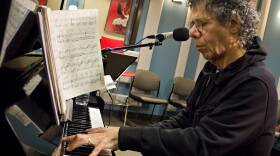Listen to the story above or read the script below:
That’s Machito and his Afro-Cubans. The piece is called "Tanga," composed in 1943 by trumpeter and arranger Mario Bauzá. The song title was supposedly derived from an African word for marijuana.
Cuban-born Bauzá was in Cab Calloway's orchestra in New York when he decided to put together his own sophisticated big band, and play original jazz arrangements over Afro-Cuban rhythms. Bauzá had his brother-in-law Francisco Grillo, also known as "Machito," front the band.
"Tanga” became the band's theme song. It was the first original American jazz piece written "en clave;" that is, in a specifically Afro-Cuban rhythm.
The band's name, the Afro-Cubans, was the first acknowledgement that the so-called "Latin" rhythms that were making their way into American music actually originated in Africa.
A side-note: trumpeter Arturo Sandoval objects to the term “Latin jazz.” He said in a PBS interview several years ago: “ ’Latin’ jazz? What is Latin, it’s a language you only hear in church. Our music is Afro-Cuban music.”
Point taken, Arturo.
In 1947, Cuban conga drummer and composer Chano Pozo joined Dizzy Gillespie’s band onstage at Carnegie Hall.
The song “Manteca,” composed by Gillespie and Pozo together, was the next step toward a new form of Afro-Cuban jazz.
By the 1960s, politics prevented most Cuban musicians from coming into the United States.
But with the influx of Puerto Ricans settling in New York, and the Black community’s growing interest in their African roots, Afro-Latin music started blending with pop, rock and roll, soul and jazz.
Hit records of 1963 included Tito Puente’s “Oye Como Va”, saxophonist Sonny Rollins’ Caribbean-flavored “St. Thomas,” and Cuban percussion master Mongo Santamaria’s cover of Herbie Hancock’s “Watermelon Man.”
Dizzy Gillespie once told me that out of all the music of this hemisphere that has come into jazz, Cuban music has had the biggest impact.
Works for me!
KNKX Celebrates Jazz Appreciation Month
Throughout the month of April, we will be illustrating different styles of jazz through time that make up jazz history through storytelling and music. From the early 1900’s to 2022, we will journey from Dixieland to Modern Jazz styles, Big Band to Hip Hop.
Listen to installments weekdays at 9am and 7pm on 88.5 FM and KNKX.org. See all stories from the KNKX History of Jazz project.








